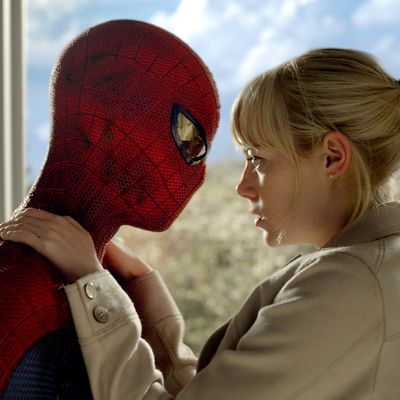
Coming barely a decade after Sam Raimi’s first Spider-Man, the “reboot” called The Amazing Spider-Man is clearly unnecessary and ought to be shunned for all kinds of reasons — chiefly to deliver a shock to the system of Hollywood execs whose primary job is finding merchandisable “franchises” and studio “tentpoles.” But for all its underlying cynicism, the new Spidey picture is pretty damn good. The lesson should not be that lazy multiplex viewers and Comic-Con fanatics will pay to see anything with Marvel’s name on it, but that first chapters — a.k.a. “origin stories” — are easier to make and more reliably fun. By the time part three of a blockbuster superhero saga rolls around, the lead actors have aged out of their roles and are impatient to prove they can carry “serious” (i.e., Oscar-bait) movies, while the filmmakers, their edges blunted by too much money and unable to think about complex, long-term story arcs the way TV creators can, flop about in misery, their brains grinding emptiness. Why not start the whole thing over with a younger, hungrier, less expensive crew?
I’m not making the case for a movie like The Amazing Spider-Man — only saying it’s fresher than Raimi & Co.’s shambolic Spider-Man 3. (No, it can’t touch Spider-Man 2, the best of all the Marvel pictures.) The new Peter Parker is Andrew Garfield, the glowering dweeb from The Social Network, and where Tobey Maguire was soft-faced and mild, examining his sudden, sticky excretions with an adolescent’s wonderment, Garfield is high-strung and angry — and those excretions don’t come naturally. (This Peter has to build his web-jets.) Because a primal trauma must kick-start every superhero career, we’ve seen little Peter lose his parents (Campbell Scott as his scientist dad, Embeth Davidtz as his mom) in the prologue, and high-school Peter beaten up by bullies. His powers emerge spasmodically, twisting him in knots, his body with a mind of its own. The problem with the first Spider-Man was that whenever Maguire got into his suit, he transformed into a little video-game fellow swinging around an artificial cityscape, fluidity trumping realism. Director Marc Webb makes the flights more jagged, mixing up his angles and adding Spidey-eye views for the wheeee factor. At one point, Peter channels Ratso Rizzo: “I’m swingin’ here!” You don’t get that weightless, inhuman CGI vibe as powerfully.
Like many superhero pictures, The Amazing Spider-Man has more self-empowering messages than there are placards at a Maoist convention. A poster of Albert Einstein carries the banner, “Imagination is more important than knowledge.” Peter’s uncle (Martin Sheen, ever the voice of the liberal conscience) preaches moral responsibility — the social good taking precedence over freedom of choice. Politics-shmolitics: Americans now get most of their civic lessons from masked men in Spandex. A strikingly handsome Rhys Ifans plays the Jekyll/Hyde figure, Dr. Curt Connors, once Peter’s father’s best friend. Having only one arm, he sits in his lab and stares longingly at lizards flitting around their aquaria, losing their tails and growing them back with aplomb. Reptiles are the master race, he concludes. Everyone should be turned into reptiles. His scheme doesn’t make much sense, but give it points for weirdness. The lizard metamorphoses mean there’s so much CGI that the artists’ and programmers’ names are scrolling long after you’ve exited the restroom and headed for home.
I’ve saved the best for last: The love interest played by that throaty redheaded (here blonde) darling Emma Stone, whose blue eyes radiate so much intelligence that any actor on whom she trains them in adoration becomes an instant movie star. Lucky Garfield, getting to play scenes like the one in which Peter tries to tell Stone’s Gwen Stacy what happened after a chemically mutated spider dropped down his shirt. “I’ve been bitten … ” he stammers. “So have I,” Stone says, sighing, and melting him with her gaze. CGI is superfluous.
This story appeared in the July 21, 2012 issue of New York Magazine.


